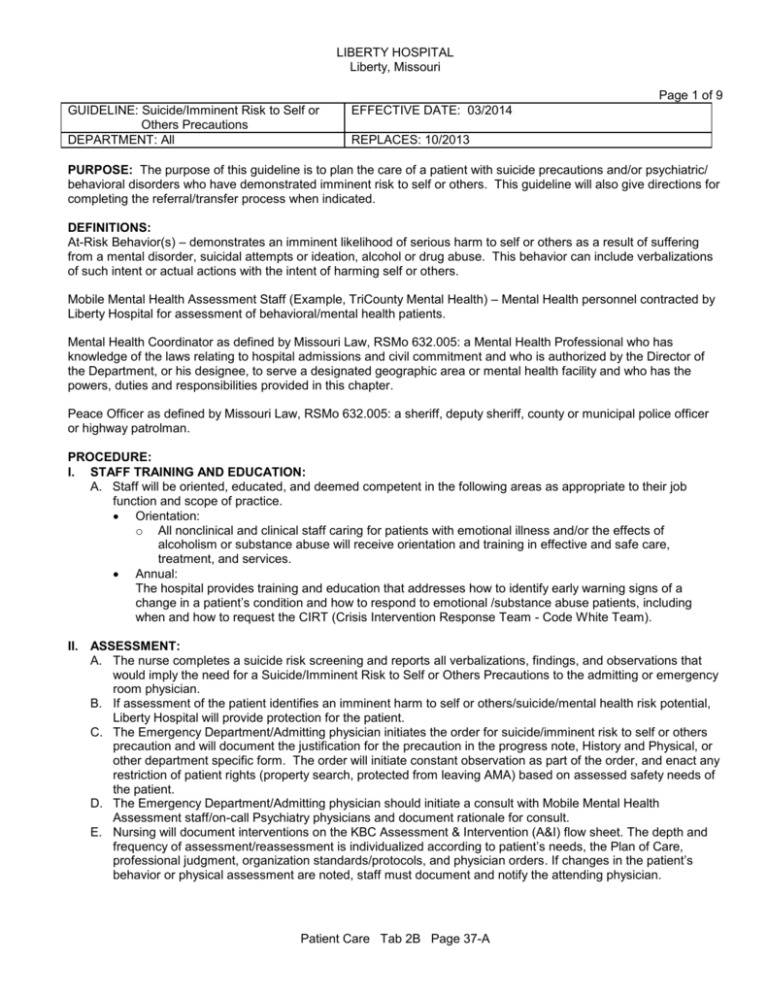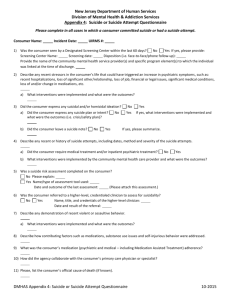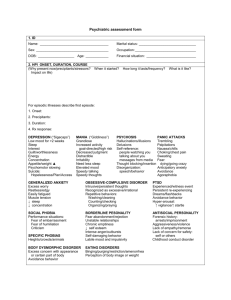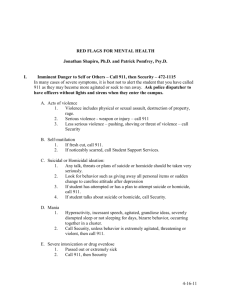Suicide-Imminent Risk to Self or Others Precautions
advertisement

LIBERTY HOSPITAL Liberty, Missouri Page 1 of 9 GUIDELINE: Suicide/Imminent Risk to Self or Others Precautions DEPARTMENT: All EFFECTIVE DATE: 03/2014 REPLACES: 10/2013 PURPOSE: The purpose of this guideline is to plan the care of a patient with suicide precautions and/or psychiatric/ behavioral disorders who have demonstrated imminent risk to self or others. This guideline will also give directions for completing the referral/transfer process when indicated. DEFINITIONS: At-Risk Behavior(s) – demonstrates an imminent likelihood of serious harm to self or others as a result of suffering from a mental disorder, suicidal attempts or ideation, alcohol or drug abuse. This behavior can include verbalizations of such intent or actual actions with the intent of harming self or others. Mobile Mental Health Assessment Staff (Example, TriCounty Mental Health) – Mental Health personnel contracted by Liberty Hospital for assessment of behavioral/mental health patients. Mental Health Coordinator as defined by Missouri Law, RSMo 632.005: a Mental Health Professional who has knowledge of the laws relating to hospital admissions and civil commitment and who is authorized by the Director of the Department, or his designee, to serve a designated geographic area or mental health facility and who has the powers, duties and responsibilities provided in this chapter. Peace Officer as defined by Missouri Law, RSMo 632.005: a sheriff, deputy sheriff, county or municipal police officer or highway patrolman. PROCEDURE: I. STAFF TRAINING AND EDUCATION: A. Staff will be oriented, educated, and deemed competent in the following areas as appropriate to their job function and scope of practice. Orientation: o All nonclinical and clinical staff caring for patients with emotional illness and/or the effects of alcoholism or substance abuse will receive orientation and training in effective and safe care, treatment, and services. Annual: The hospital provides training and education that addresses how to identify early warning signs of a change in a patient’s condition and how to respond to emotional /substance abuse patients, including when and how to request the CIRT (Crisis Intervention Response Team - Code White Team). II. ASSESSMENT: A. The nurse completes a suicide risk screening and reports all verbalizations, findings, and observations that would imply the need for a Suicide/Imminent Risk to Self or Others Precautions to the admitting or emergency room physician. B. If assessment of the patient identifies an imminent harm to self or others/suicide/mental health risk potential, Liberty Hospital will provide protection for the patient. C. The Emergency Department/Admitting physician initiates the order for suicide/imminent risk to self or others precaution and will document the justification for the precaution in the progress note, History and Physical, or other department specific form. The order will initiate constant observation as part of the order, and enact any restriction of patient rights (property search, protected from leaving AMA) based on assessed safety needs of the patient. D. The Emergency Department/Admitting physician should initiate a consult with Mobile Mental Health Assessment staff/on-call Psychiatry physicians and document rationale for consult. E. Nursing will document interventions on the KBC Assessment & Intervention (A&I) flow sheet. The depth and frequency of assessment/reassessment is individualized according to patient’s needs, the Plan of Care, professional judgment, organization standards/protocols, and physician orders. If changes in the patient’s behavior or physical assessment are noted, staff must document and notify the attending physician. Patient Care Tab 2B Page 37-A LIBERTY HOSPITAL Liberty, Missouri GUIDELINE: Suicide/Imminent Risk to Self or Others Precautions Page 2 of 9 F. For patients who are admitted and on Suicide/Imminent Risk to Self or Other precautions, nursing will individualize the Plan of Care utilizing the Suicide Risk or Potential for Injury Clinical Practice Guideline (based upon assessment). Patient specific individualization should occur. III. SUICIDE/IMMINENT RISK TO SELF OR OTHERS PRECAUTIONS: A. A staff member is assigned to constant observation of the patient (Addendum A– Constant Observation Worksheet for the Observer). 1. Constant observation may be initiated by the RN with prompt physician notification. 2. Staff providing constant observation must maintain view of the patient at all times- including when toileting/showering/sleeping. Staff should never leave the patient until relieved by other staff. 3. Under no circumstances will the patient be left alone or allowed to sleep with sheets or blankets over their heads. B. Engage the person at risk and his or her family in the care plan. Explain to the patient/family the rationale for use of Suicide/Imminent Risk to Self or Others Precautions. Nursing can use Addendum B - What to Expect as a Patient on Constant Observation Status. C. Place the patient into a hospital gown and take shoes as soon as possible. (Refer to Patient Rights/ Restriction of Patient Rights guideline). D. To make the room as safe as possible, remove any unnecessary room items that could be a dangerous object or used as a ligature device. (See list --VIII. Safe Environment). Place the OPEN ORANGE DOOR alert placard on the doorframe/room access area to notify staff of the precaution in place. (Addendum C) E. Patients’ belongings will be searched by 2 staff members in presence of the patient if the patient is alert and oriented. If the patient is unable or unwilling to be present for the search of personal items, annotate on the inventory form in the indicated checkbox. F. When searching items, any containers are to be opened. Clothing and all potentially dangerous objects (weapons, matches, cigarette lighters, or other dangerous objects) are removed from the room and secured. Inform security if any weapon(s) or drugs/drug paraphernalia or illegal contraband is/are discovered. These items will be confiscated and secured by a hospital security officer, or a law enforcement officer. Utilize the “Patient Personal Belongings” inventory form to document patient’s personal items present. Following inventory of items, have the patient and the two staff members sign the form. Place in the permanent medical record. (Addendum – D: Patient Personal Belongings” inventory form). Notify security of order for Suicide/Imminent Risk to Self or Others Precautions. G. Visitors will be instructed to check at the nurses’ station before visiting. Visitors will be asked not to take any personal belongings into the area with the patient. H. Patient may leave the room only for physician-ordered tests or procedures and will be accompanied by the staff member providing constant observation care. I. When possible, room/bed assignment should be away from exits and ante-rooms. IV. ACTIONS IF A SUICIDE/IMMINENT RISK TO SELF OR OTHERS PRECAUTIONS PATIENT WANTS TO LEAVE: A. Suicide/Imminent Risk to Self or Others Precautions are based on the assessment and reassessment of the patient and the risk of harm to self or others. If a patient has been assessed by staff as imminent risk of harm to self or others, then Liberty Hospital has a responsibility to keep the patient safe until appropriate mental health care is obtained. B. If the patient is medically unstable and cannot be placed in mental health services until the medical issue has resolved, staff must take measures to hold a patient to prevent the patient from leaving against medical advice. If patient attempts to leave while under Suicide/Imminent Risk to Self or Others Precautions: 1. Attempt verbal redirection; 2. Call Code White; 3. Do not allow to leave AMA C. The order for Suicide/Imminent Risk to Self or Others Precautions allows Liberty Hospital Staff to hold a patient to prevent them from leaving. The ability to hold a patient versus leaving Against Medical Advise (AMA) will be maintained until the Suicide/Imminent Risk to Self or Others Precautions is discontinued by the psychiatrist or the admitting physician. (Refer to Patient Rights/Restriction of Patient Rights Guideline) When the order for Suicide/Imminent Risk to Self or Others Precautions is discontinued the individual may be allowed to leave AMA. Patient Care Tab 2B Page 37-B LIBERTY HOSPITAL Liberty, Missouri GUIDELINE: Suicide/Imminent Risk to Self or Others Precautions Page 3 of 9 Patients who do not have an order for Suicide/Imminent Risk to Self or Others Precautions have been seen and cleared by Psychiatry or the admitting physician may be allowed to leave AMA (Refer to AMA guideline). D. Staff should use best efforts to keep the patient at Liberty Hospital utilizing all trained behavioral health techniques. Physical holds should be utilized prior to chemical and/or mechanical restraint. (Refer to Restraint Guideline). Mechanical restraint is a last resort after least restrictive means and attempts have failed to secure the patient’s safety. These attempted interventions are to be documented in the medical record. V. DISCONTINUATION OF SUICIDE/IMMINENT RISK TO SELF OR OTHERS PRECAUTIONS: A. The attending physician will discontinue the Suicide/Imminent Risk to Self or Others Precaution. B. Documentation that the patient is not in imminent risk of harm to self or others and they are not needing acute in-patient psychiatric (this does not include residential treatment*) treatment is to be documented by a physician. VI. TRANSFER OF THE SUICIDE/IMMINENT RISK TO SELF OR OTHERS PRECAUTIONS PATIENT: A. Mobile Mental Health Assessment staff or a Psychiatrist will evaluate the patient for psychiatric needs, including a possible transfer. If inpatient psychiatric therapy is indicated, the admitting physician will order a psychiatric evaluation and assist transfer to an inpatient psychiatric unit. B. Liberty Hospital inpatient transfers may be arranged by a Mental Health Mobile Assessment Coordinator or Social Services. C. When another facility has agreed to receive the patient and the patient is stable for transfer, arrange for transfer according to established guidelines. D. Send copies of medical record, lab results and any other pertinent information when transferring a patient to a psychiatric facility as outlined in the “Transfer of a Patient to Another Facility” guideline. E. If the patient is transferred to another facility their belongings will be secured with the transport staff and will accompany the patient to the receiving facility; except for weapons, illicit / illegal drugs or drug paraphernalia which will be turned over to law enforcement. Document disposition of personal belongings on the Patient Personal Belongings inventory form (Addendum D), and have patient or the patient’s representative sign on the indicated space on form. If the patient is either unwilling or unable, nursing will annotate on the inventory form that the belongings were given to. That person receiving the patient’s belongings will sign the Patient Personal Belongings form in the area for Return of Personal Items in the signature box. F. If the patient is discharged to home for outpatient treatment, personal belongings will be returned to the patient; except for weapons, illicit / illegal drugs or drug paraphernalia which will be turned over to law enforcement. Document disposition of personal belongings on last column of Patient Personal Belongings inventory, and have patient sign on the indicated space on the form. VII. INVOLUNTARY HOLDS/RSMo 632.305 A. An at-risk patient unwilling to enter inpatient psychiatric treatment may require an Involuntary Hold (96 Hour Hold) at a psychiatric facility. A 96-hour involuntary hold cannot be initiated within Liberty Hospital. B. Involuntary holds of patients can be initiated by mental health coordinators or peace officer when they have reasonable cause to believe that such person is suffering from a mental disorder and there is IMMINENT likelihood of serious harm by such person to him/herself or others. C. Affidavits may be requested from Liberty Hospital staff if they have first hand personal observation/knowledge of patient exhibited behaviors that could assist the mental health coordinator support an Involuntary Hold to a mental health facility. These observations should be put to writing on an Affidavit (See addendum E – DMH 142). Affidavits ARE NOT required to initiate/maintain a patient on medically ordered Suicide/Imminent Risk to Self or Others Precautions. D. AFFIDAVITS are not required for Suicide/Imminent Risk to Self or Others Precautions to be initiated and will be obtained only at the request of mental health coordinators for the purpose of an involuntary hold to a psychiatric facility. E. If an affidavit is requested, the Affidavit must be notarized. Affidavits can only be requested from staff or personnel who had first hand account of the patient’s behaviors. Send the original with patient to psychiatric facility, and place a copy on the chart. Patient Care Tab 2B Page 37-C LIBERTY HOSPITAL Liberty, Missouri GUIDELINE: Suicide/Imminent Risk to Self or Others Precautions Page 4 of 9 F. If a patient is evaluated by the mental health coordinator or psychiatrist and inpatient psychiatric placement is recommended, and the patient/legal guardian refuses to voluntarily consent to that placement, social services needs to be consulted to facilitate an involuntary commitment. (Social services will facilitate the paperwork required to provide to the probate court.) The SUICIDE/IMMINENT RISK TO SELF OR OTHERS PRECAUTION will remain in place while an involuntary placement is being coordinated. VIII. SAFE ENVIRONMENT CONTINUOUS OBSERVATION: SUICIDE/IMMINENT RISK TO SELF OR OTHERS PRECAUTIONS: A. For patients who present an imminent likelihood of serious harm to self or others, remove all harmful objects from the patient’s environment. Examples are listed below. NOTE: THIS IS NOT A COMPREHENSIVE LIST, discretion is to be used. 1. Any toxic substance, cleaners 2. Any Medications 3. Sharp objects – razors, knives, pencils, pens, pins, wire hangers 4. Glass containers 5. Plastic trash bags 6. Extra linens 7. Patient’s clothing and shoes – should be kept at the nursing station. 8. Phones with cords, cells phones are allowed. 9. Plants 10. Sharps container 11. Unnecessary medical tubing 12. Unused restraints 13. Unnecessary gait belts 14. If possible, remove any cord-like item with a length greater than 6 inches (about a hands length) B. Food is to be served on styrofoam dishes with plastic silverware - spoon and fork only. No soda/juice cans – pour all beverages into styrofoam/plastic cup. Plastic utensils will be collected with meal tray. C. Visitors will be asked to leave personal items in their cars and will not be allowed to take into the patient room. E. Continuous Observation Sitter IX. DOCUMENTATION: A. Document patient’s behavior in the Emergency Department Record or A & I Flow sheet; and on the Patient Sitter Log. B. Order for Suicide/Imminent Risk to Self or Others Precautions by a physician. C. Department of Mental Health, Affidavit in Support of Application for Detention, Evaluation, Treatment Rehabilitation-Admission for 96 hours (Addendum E) if requested from staff who can specify factual information through personal observation of behaviors that the patient is in imminent danger or likelihood of serious harm to him/herself or others. D. If protective hold, chemical or mechanical restraint, or seclusion is required for patient safety, refer to Restraint Guideline. E. If the patient is to be held, refer to the Patient Rights/Restriction of Patient’s Rights Guideline. F. Document history, vital signs, behaviors, patient’s statements, suicidal indications, sensorium, possible drug or alcohol ingestion and significant past medical and psychiatric history. G. Profile/Emergency Department Record, Physician’s Progress Notes, Significant Event, Education Record, Evaluation Documentation, Inter-Hospital Transfer Form. H. Document personal belongings on the Patient Personal Belongings Inventory Form. X. REFERENCES: TJC Sentinel Event Alert #46 – Suicidal patients; TJC 2013; PC.01.01.01 EP 24 TJC RI.01.06.05 – Rights to an environment that preserves dignity and positive self-image. TJC NSPG.15.01.01 – Identify Patients at Risk for Suicide Joint Commission on Accreditation of Healthcare Organizations 2007 Patient Safety Goals on Suicide Missouri Revised Statues: Chapter 631 Alcohol and Drug Abuse Section 631.120 Chapter 632 Comprehensive Psychiatric Services Section 632.305 GUIDELINE: Suicide/Imminent Risk to Self or Others Precautions Page 5 of 9 Patient Care Tab 2B Page 37-D LIBERTY HOSPITAL Liberty, Missouri Chapter 632 Comprehensive Psychiatric Services Section 632.310 Chapter 632 Comprehensive Psychiatric Services Section 632.440 XI. HISTORY: Revised 03/14 Revised 10/12 Renamed 10/12 Linked 06/09 Combined 01/03 Revised 02/07 Revised 05/06 Reviewed 04/03 Revised 03/03 Revised 06/00 Revised 12/97 Revised 07/95 Approved 04/92 Revised 03/92 05/88 Risk Management Suicide Precaution work group Was, Suicide Precautions and/or Psychiatric-Behavioral Disorders Guideline linked to affidavit known as “addendum A” Combines Suicide Precautions with Psychiatric/Behavioral Disorders Suicide Precautions work group. PORT, Dr. Todd Hill P. Jones, Dr. Hill, Nursing Practice Council Nursing Practice Council Education (Marta Lawson) Education (Ginger Filbert) Assessment Committee Guideline Committee Nursing Management Group Policy & Procedure Committee Angie Twite XII. APPROVAL: DATE: ______________________________________________ David Feess, President and CEO __________________ ___________________________________________ Shirley Heintz, Vice President of Patient Care __________________ ______________________________________________ Mike Waldschmidt, M.D., Medical Staff President __________________ Patient Care Tab 2B Page 37-E LIBERTY HOSPITAL Liberty, Missouri GUIDELINE: Suicide/Imminent Risk to Self or Others Precautions Page 6 of 9 Addendum A - Constant Observation Worksheet for Observers Staff members; please use this as a guide to expectations while assigned constant observation of a patient. You must: *Be in room with patient at all times *Must not be distracted. Do not read or watch TV, read, perform charting – You must focus on the patient *Do not allow patient to cover their heads with blankets *Breaks will be scheduled; do not leave the patient for any reason *Ensure room risks are also observed, such as oxygen tubing, catheter tubing, shower fixtures, etc…These are items a patient could use to harm themselves and you must monitor these devices if in the room with the patient. *Complete an Orange Door Patient Sitter Log PROVIDING A SAFE ENVIRONMENT: Patient rooms must be a safe environment or constantly observed where not possible to remove the high risk items/fixtures. Rooms not designated as a “safe room” require steps for safety. Remove any of the following items (not an inclusive list, use your judgment what potentially could be dangerous): 1. Any toxic substance, cleaners 2. Any Medications 3. Sharp objects- razors, knives, pencils, pens, pins, wire hangers 4. Glass containers 5. Plastic trash bags 6. Extra linens 7. Patient’s clothing and shoes -should be kept at the nursing station. 8. Phones with cords, cells phones are allowed. 9. Plants 10. Sharps container 11. Unnecessary medical tubing 12. Unused restraints 13. Unnecessary gait belts 14. If possible, remove any or cord-like item with a length greater than 6 inches (about a hands length) PATIENT BELONGINGS: With a continuous observation order, patients’ belongings are searched by 2 staff members in presence of the patient if the patient is alert and oriented. If the patient is unable or unwilling to be present for the search of personal items, annotate on the inventory form in the indicated checkbox. When searching items, any containers are to be opened. Clothing and all potentially dangerous objects are removed and secured in a safe place outside of patient room/area. Document in chart what is removed and where it is stored. Supervise meal trays prior to delivering to patient: Styrofoam dinnerware only. No glass or cans. Open all beverages into plastic or Styrofoam cups. Plastic utensils with meals (no knives). Plastic utensils must be collected once meal completed. Affidavits documenting observed behavior which shows an immediate harm to self or others are completed as ONLY as requested by a trained mental health coordinator. GENERAL INFORMATION: 1. Take the patient seriously. Never leave the patient un-observed---even in bathroom or shower 2. Listen to the patient. Let the person talk about their troubles and feelings. Many will deny that they are a danger to themselves or others. That is a medical assessment. 3. Support them emotionally by listening and affirming their feelings, but do not offer advice or talk about yourself. 4. Accompany the patient to all tests/ procedures off of nursing unit. GUIDELINE: Suicide/Imminent Risk to Self or Others Precautions Patient Care Tab 2B Page 37-F Page 7 of 9 LIBERTY HOSPITAL Liberty, Missouri GUIDELINE: Suicide/Imminent Risk to Self or Others Precautions Patient Care Tab 2B Page 37-G Page 8 of 9 LIBERTY HOSPITAL Liberty, Missouri Addendum B – What to Expect as a Patient on Constant Observation Status Your doctor has ordered precautions that require your constant observation. You can expect to….. 1. Be taken seriously; 2. Be listened to; 3. Be asked if you are having thoughts of suicide; 4. NOT to be left alone at any time; 5. Have your personal belongings searched in your presence for potentially harmful items; 6. Have personal items taken and placed in a safe area of the hospital until your discharge or transfer, at which time selected items may be returned back to you. If you are transferred to another facility your belongings will be secured with the transport staff and will accompany you to the receiving facility. Weapons, illicit/ illegal drugs or drug paraphernalia will not be returned to you upon discharge or transfer; 7. You will be asked to wear a hospital gown and your shoes will be stored. We will provide you foot covers 8. You will receive limited numbers of visitors and visitors will be asked to leave personal articles outside your room; 9. Be accompanied by your staff observer to the restroom and shower; be accompanied to tests/procedures which occur away from the assigned nursing unit; 10. Be monitored while you rest or sleep. Patient Care Tab 2B Page 37-H LIBERTY HOSPITAL Liberty, Missouri GUIDELINE: Suicide/Imminent Risk to Self or Others Precautions Addendum C OPEN ORANGE DOOR alert placard Patient Care Tab 2B Page 37-I Page 9 of 9








